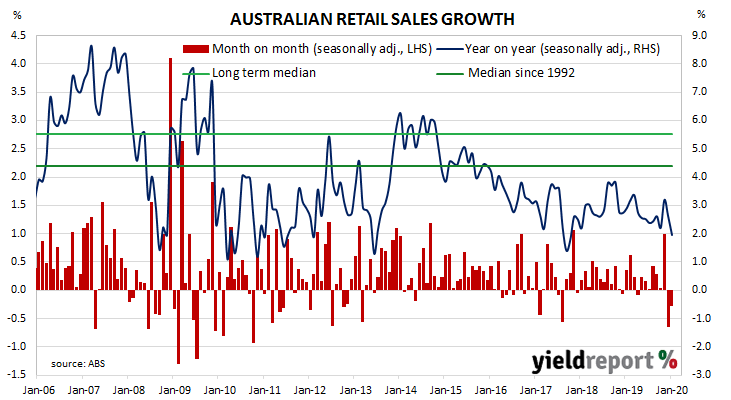Growth figures of domestic retail sales have been declining since 2014 and they reached a low-point in September 2017 when they registered an annual growth rate of just 1.5%. They then began increasing for about a year, only to stabilise at around 3.0% to 3.5% through late 2018 before trending lower through 2019. January’s figures have continued that trend and economists do not see signs of a turnaround any time soon.
According to the latest ABS figures, total retail sales fell by 0.3% in January on a seasonally-adjusted basis, a larger decline than the flat result which had been expected but not as negative as December’s -0.7% after it was revised down from -0.5%. On an annual basis, retail sales increased by only 2.0%, as compared to December’s comparable figure of 2.6% after revisions.
Westpac senior economist Matthew Hassan said, “Overall, looking through monthly sales-related volatility and temporary bushfire effects, the underlying trend is still clearly weak.”

US Treasury yields had fallen heavily overnight and domestic bond yields followed to some extent except at the short end where yields increased surprisingly. By the end of the day, the 3-year ACGB yield had gained 2bps to 0.38% while the 10-year yield had lost 6bps to 0.61% and the 20-year yield had dropped by 11bps to 0.99%.
Expectations of another cut in the cash rate target in the next month or two firmed up even further. By the end of the day, April contracts implied a rate cut had been fully built in, the same as at the end of the previous day’s trade. However, further rate cuts were seen as not particularly likely and contracts out to December 2020 typically implied a 20%-25% chance of a rate cut down to zero.
ANZ economist Adelaide Timbrell described the fall as “much sharper decline than expected” and the coronavirus “may have been behind part of January’s weakness, along with the bushfires.” She expects the retail sector to be hit “substantially” in coming months.

